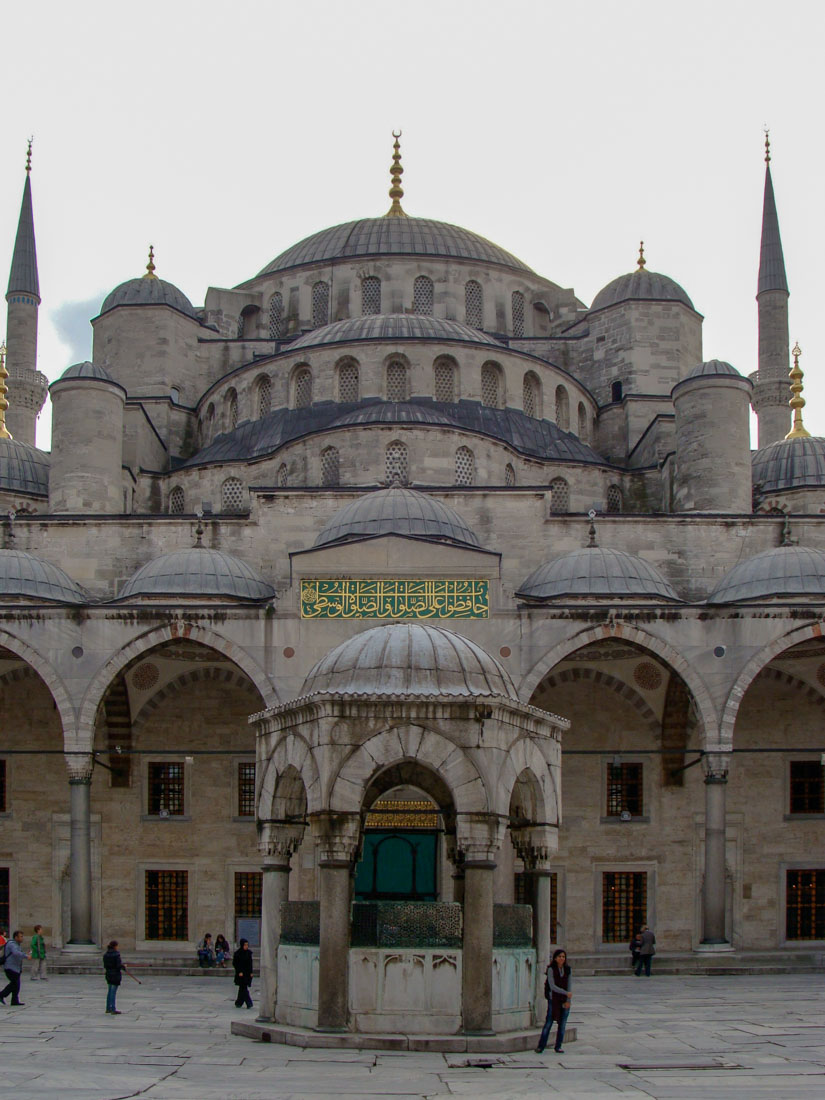 |
 |
 |
 |


Sultan Ahmed Cami (Blue Mosque)
Istanbul
1609 - 1616
The Sultan Ahmed Cami is a historic mosque in Istanbul, built according to a design by Mehmed Ağa.
The building was popularly nicknamed Blue Mosque, due to the striking
color of the hand-painted tiles on the interior walls of the mosque.
The impressive building was built between 1609 and 1616 during the
reign of Ahmed I. The design for the Sultan Ahmed Cami is based on the
one hand on the famous Hagia Sophia and on the other hand on the work
of the master Mimar Sinan. The Blue Mosque is a design of perfect
symmetry. Characteristic is the large dome, which is supported by four
semi-domes. Six minarets and numerous smaller domes are arranged around
this central peak. The Sultan Ahmed Cami is considered the culmination
of two centuries of Ottoman mosque architecture, and the last major
mosque of the classical period.
The court with the well for the washing is very similar to that of the Süleymaniye Mosque. This courtyard has approximately the same dimensions as the mosque itself. A continuous arcade separates the courtyard from the mosque. Four of the six minarets stand at the corners of the Blue Mosque. Each of these ribbed minarets has three balconies (şerefe) with stalactite consoles. The two other minarets are located at the end of the forecourt, and have only two balconies. In addition to the already mentioned tiles, more than 200 glass windows of complex design impress in the interior. Various verses from the Koran adorn the interior. Many of them are by Seyyid Kasim Gubari, who is considered the greatest calligrapher of his time. The most important element inside the Blue Mosque is the mihrab made of finely worked marble. The mihrab with its stalactite niche is surrounded by numerous windows.
Die Sultan Ahmed Cami ist eine historische Moschee in Istanbul, welche nach einem Entwurf von Mehmed Ağa errichtet wurde. Das Gebäude erhielt im Volksmund den Übernamen Blaue Mosche, was auf die prägende Farbe der handbemalten Fliesen an den Innenwänden der Moschee zurückzuführen ist. Das beeindruckende Gebäude wurde von 1609 bis 1616 während der Herrschaft von Ahmed I. erbaut. Der Entwurf für die Sultan Ahmed Cami basiert einerseits auf der berühmten Hagia Sophia und andererseits auf dem Werk des Meisters Mimar Sinan. Bei der Blauen Moschee handelt es sich um einen Entwurf von perfekter Symmetrie. Charakteristisch ist die grosse Kuppel, welche von vier Halbkuppen getragen wird. Sechs Minarette und zahlreiche kleinere Kuppeln sind um diesen zentralen Höhepunkt arrangiert. Die Sultan Ahmed Cami gilt als Höhepunkt von zwei Jahrhunderten osmanischer Moscheenarchitektur, und als letzte grosse Moschee der Klassik.
Der Hof mit dem Brunnen für die Waschmöglichkeit ist demjenigen der Süleymaniye-Moschee sehr ähnlich. Dieser Hof weist etwa die selben Dimensionen wie die Moschee selbst auf. Eine durchgehende Arkade trennt den Hof von der Moschee. Vier der sechs Minarette stehen an den Ecken der Blauen Moschee. Jedes dieser geriffelten Minarette weist drei Balkone (şerefe) mit Stalaktitkonsolen auf. Die zwei weiteren Minarette befinden sich am Endes des Vorhofs, und weisen lediglich zwei Balkone auf. Nebst den bereits erwähnten Fliesen beeindrucken im Innenraum mer als 200 Glasfenster von komplexer Gestaltung. Verschiedene Verse aus dem Koran zieren den Innenraum. Viele davon stammen von Seyyid Kasim Gubari, der als grösster Kalligraph seiner Zeit gilt. Das wichtigste Element im Inneren der Blauen Mosche ist der Mihrab aus fein gearbeitetem Marmor. Der Mihrab mit seiner Stalaktit-Nische ist von zahlreichen Fenster umgeben.
The court with the well for the washing is very similar to that of the Süleymaniye Mosque. This courtyard has approximately the same dimensions as the mosque itself. A continuous arcade separates the courtyard from the mosque. Four of the six minarets stand at the corners of the Blue Mosque. Each of these ribbed minarets has three balconies (şerefe) with stalactite consoles. The two other minarets are located at the end of the forecourt, and have only two balconies. In addition to the already mentioned tiles, more than 200 glass windows of complex design impress in the interior. Various verses from the Koran adorn the interior. Many of them are by Seyyid Kasim Gubari, who is considered the greatest calligrapher of his time. The most important element inside the Blue Mosque is the mihrab made of finely worked marble. The mihrab with its stalactite niche is surrounded by numerous windows.
Die Sultan Ahmed Cami ist eine historische Moschee in Istanbul, welche nach einem Entwurf von Mehmed Ağa errichtet wurde. Das Gebäude erhielt im Volksmund den Übernamen Blaue Mosche, was auf die prägende Farbe der handbemalten Fliesen an den Innenwänden der Moschee zurückzuführen ist. Das beeindruckende Gebäude wurde von 1609 bis 1616 während der Herrschaft von Ahmed I. erbaut. Der Entwurf für die Sultan Ahmed Cami basiert einerseits auf der berühmten Hagia Sophia und andererseits auf dem Werk des Meisters Mimar Sinan. Bei der Blauen Moschee handelt es sich um einen Entwurf von perfekter Symmetrie. Charakteristisch ist die grosse Kuppel, welche von vier Halbkuppen getragen wird. Sechs Minarette und zahlreiche kleinere Kuppeln sind um diesen zentralen Höhepunkt arrangiert. Die Sultan Ahmed Cami gilt als Höhepunkt von zwei Jahrhunderten osmanischer Moscheenarchitektur, und als letzte grosse Moschee der Klassik.
Der Hof mit dem Brunnen für die Waschmöglichkeit ist demjenigen der Süleymaniye-Moschee sehr ähnlich. Dieser Hof weist etwa die selben Dimensionen wie die Moschee selbst auf. Eine durchgehende Arkade trennt den Hof von der Moschee. Vier der sechs Minarette stehen an den Ecken der Blauen Moschee. Jedes dieser geriffelten Minarette weist drei Balkone (şerefe) mit Stalaktitkonsolen auf. Die zwei weiteren Minarette befinden sich am Endes des Vorhofs, und weisen lediglich zwei Balkone auf. Nebst den bereits erwähnten Fliesen beeindrucken im Innenraum mer als 200 Glasfenster von komplexer Gestaltung. Verschiedene Verse aus dem Koran zieren den Innenraum. Viele davon stammen von Seyyid Kasim Gubari, der als grösster Kalligraph seiner Zeit gilt. Das wichtigste Element im Inneren der Blauen Mosche ist der Mihrab aus fein gearbeitetem Marmor. Der Mihrab mit seiner Stalaktit-Nische ist von zahlreichen Fenster umgeben.